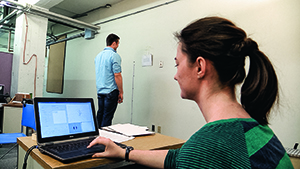THE MOVING ROOM in the basement of Cooke Hall sprang to life when kinesiology professor Thomas Stoffregen clicked a button. In just seconds, the room’s movements induce an off-balance feeling, sending many participants stumbling backwards, some sick to their stomachs.
But Stoffregen and the undergraduate and graduate researchers in the Affordance Perception–Action Laboratory (APAL) are not discouraged by the queasiness.
They research it.
“No one has ever tossed their cookies in my lab,” says Stoffregen.
The lab’s achievements, however, go far beyond that. APAL (pronounced “apple”) is a leader in quantitative research about the relationship between perception and action.
“I routinely run into people in kinesiology who know little or nothing about the research regarding motion sickness and are surprised we’re doing it,” Stoffregen says.
APAL is the successor to the Human Factors Research Laboratory, founded in the 1990s by Peter Hancock. Stoffregen, the lab’s current director, came to the University in 2001.
The lab is currently occupied with four projects, some engaging undergraduate researchers. This year, two students were awarded grants from the Undergraduate Research Opportunities Program (UROP) to assist with cutting-edge projects.
Half the population
Meg Diedrick, a junior in the College of Biological Sciences studying biology, plans to study physical therapy. After doing a bit of research on her own, she knew she wanted to work at APAL.
“A lot of my friends work in medical labs, and I find that interesting,” says Diedrick, “but when I came here, it all made sense.”

But getting a research gig in the lab is not easy. Most students reach out to Stoffregen after taking one of his courses.
“She had to convince me,” says Stoffregen. “We had a nice conversation and it became very obvious that she was for real. I’m happy to have her.”
Specifically, Diedrick will test motion sickness differences between males and females. Though motion sickness has been studied for decades—most of it mapped out by the military in the 1960s and ’70s—the data has a gaping hole: nearly all of the research had been conducted on male subjects.
“It turns out that everything we know about this as a general phenomenon we only know about half of the population,” says Stoffregen.
Diedrick and graduate researchers on the APAL team will call attention to the fact that knowledge concerning the other half of the population, women, is unknown. While it is known that women in general are more susceptible to motion sickness than men, research concerning stimulus differences between sexes still needs to be investigated.
Stoffregen rejects the traditional idea that motion sickness is related to the inner ear; rather, it is connected to the way humans control their bodies, which differs between men and women based on typical size and weight distribution.
The team will perform their research with the help of new technology. The Oculus Rift, developed as a virtual-reality device for video games, looks like an oversized pair of black goggles. While it is designed to “let players step inside their favorite games and virtual worlds,” it also has an awkward side effect. Many users feel nauseous or uncomfortable.
“I definitely got sick,” Diedrick says of playing games on the Oculus Rift.
She will conduct trials with experimental participants and document their feelings throughout their time using the Oculus Rift, looking at demographic differences in particular. Participants will also stand on the lab’s force plate to measure their body sway during trials.
Hefty opportunity
Chris Curry, a junior majoring in kinesiology, became involved with APAL as a sophomore after taking a class with professor Michael Wade. He has assisted Wade and Stoffregen on various experiments, including work on motion sickness.
This year, Curry is supported by a UROP grant for his project, “Neurological Correlates of Hefting via EEG.” It will add to existing literature about a person’s ability to determine how far he or she can throw an object by hefting, moving the arm up and down while holding an object.
Project participants will wear an EEG, a device that measures brain-wave activity, when they make predictions about how far they can throw. They will also wear the EEG when watching footage of individuals throwing certain objects to see if the brain-wave measurements possess any level of similarity. Finally, participants will throw items, and the result and predictions will be compared.
“Working in APAL will help me develop a solid foundation on how to conduct research,” Curry says.
It’s a rare opportunity for an undergraduate to get a close look at such research—even rarer to participate. Last year, two undergraduate researchers in APAL conducted work that led to becoming co-authors on a publication, which could become prominent, according to Stoffregen.
“Unprecedented in my lab,” he says.
Considering the lab’s groundbreaking projects and such student opportunities, undergraduates and grad students can expect a valuable educational and professional experience at APAL.
As long as they can stomach the work!
Learn more about the Affordance Perception–Action Laboratory.
Story by Claire Bramel | Photos by Greg Helgeson | Spring/summer 2015
 New technology is eclipsing the moving room in professor Tom Stoffregen's motion lab.
New technology is eclipsing the moving room in professor Tom Stoffregen's motion lab.